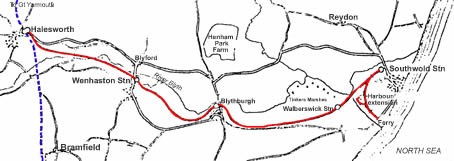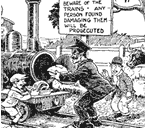| |
The
mid 1800s was the time of railway
mania when speculators were flocking
to invest in the new transportation
system. Close to home, engineer
and entrepreneur Morton
Peto was the driving force behind
the development of Lowestoft, including
bringing the railway to town. The
1840s & 50s saw a network of
lines criss-crossing Norfolk and
Suffolk. In 1854 the Halesworth,
Beccles and Haddiscoe Railway (renamed
the East Suffolk Railway Co.) was
opened between those towns and extended
via Darsham to Ipswich in 1859.
|
|
|
|
|
|
|
|
|

The River Blyth presented the major civil engineering challenge for the Railway. The bridge featured a pivoting span to allow boats to pass.
Click the picture to enlarge

Red
line denotes the Southwold Railway
with its Harbour extension.
Blue dashed line denotes LNER
Click the
map to magnify.
|
|
|
| |
Prior
to that, a number of schemes for
linking Southwold with the main
network had been promoted but failed
to gain enough support. However,
the existence of a thriving fishing
and commercial port and the growing
attractions of Southwold as a holiday
destination, led a number of local
businessmen to try again - this
time successfully. The Southwold
Railway Act was passed by Parliament
in 1876 and the Southwold Railway
Co was formed with a capital of
£53,000. It constructed a
railway linking Southwold to Halesworth
which opened in 1879. The route
of the line can be seen on the diagrammatic
map above.
Unusually for an English railway
it was narrow gauge (three feet)
and had a speed restriction of 16mph.
Mostly it had easy gradients and
the only major civil engineering
work was the swing
bridge over the River Blyth.
A branch to Southwold Harbour and
Blackshore Quay was opened in 1914
just as war broke out and the fishing
industry collapsed. It was never a success.
The carriages had no heating. Straw was strewn on the
third class carriage floors to keep passengers’
feet warm in winter. The seats were unupholstered bare wood but First class passengers had the luxury of carpeted seats and the option of a carpet-covered copper hot water bottle for their feet.

A model of a Southwold steam locomotive with passenger and goods rolling stock.
|
|
|
|
|
|
|
|
|
LIFE
ON SOUTHWOLD RAILWAY
Click
on the images below to get the
whole picture
|
|
|
|
|
|
|
|
|
|
|
|
|
|
Initially
it was a highly successful enterprise.
The year after opening it carried
65,000 passengers and 5,000 tons
of assorted freight. This rose to
108,600 and 13,8000 respectively
by 1913 but this proved to be the
peak. After that there was a slow,
inexorable decline. In 1928 there
were only 60,000 passengers.
By the 1920s
the rolling-stock and equipment
were old and worn, the speed restriction
and need to transfer the goods between
different gauges were commercial
handicaps and motor transport was
eroding traffic. All of these created
serious financial problems. The
final nail in the coffin came in
1928 when bus operators were licensed
to pick up passengers in the town.
The railway closed in 1929. There
were some attempts to reopen it
but in 1940/1 the whole railway
was broken up for scrap to aid the
war effort.
Use the links
below to explore the history of
Southwold’s other forms of
transport:
By
Road
By
water |
|
|
|
|
|
|
|
|
|
|
|
Elderly
residents remember the fun
they had with the railway
as children - before the invention
of 'Health & Safety'! |
|
|
|

"When
we heard the train we used to
belt across the Common..."

"Now
First Class was exactly the same
as Third Class except that you
had a piece of carpet on the seat."

"The
boys used to jump off, run across
the loop and get on it again on
the other side."

"We'd
go onto the bridge and wave at
the engineer..."
|
|
|
|
|
|
|
|
|
|
|
|
|
|
|
 |
|
|
|
|
|
|
|
|
 |
|
|
The
mischievous local artist who couldn't
resist having a pop at the railway.
Click
the picture to learn more about
Reg Carter
|
|
|
|
|
|
|
|
|
|
BRIDGE
ON THE RIVER BLYTH |
| |

The
piers for this original railway
swing-bridge, pictured in the early
1900s, are still there, supporting
the present pedestrian Bailey Bridge
- a shortcut to Walberswick. P017
Click
the picture to enlarge |
|
|
|
|
|
|
|
|
|
|
|
|